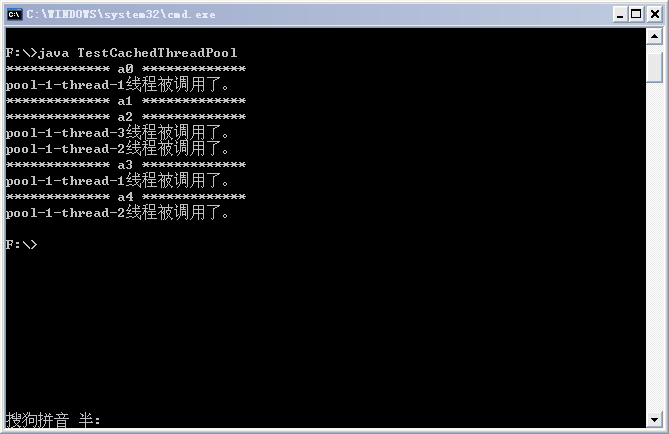每次new Thread()耗费性能
调用new Thread()创建的线程缺乏管理,被称为野线程,而且可以无限制创建,之间相互竞争,会导致过多占用系统资源导致系统瘫痪。不利于扩展,比如如定时执行、定期执行、线程中断重用存在的线程,减少对象创建、消亡的开销,性能佳
可有效控制最大并发线程数,提高系统资源的使用率,同时避免过多资源竞争,避免堵塞提供定时执行、定期执行、单线程、并发数控制等功能在Java 5之后,并发编程引入了一堆新的启动、调度和管理线程的API。
其内部使用了线程池机制,它在java.util.cocurrent 包下,通过该框架来控制线程的启动、执行和关闭,可以简化并发编程的操作。因此,在Java 5之后,通过Executor来启动线程比使用Thread的start方法更好,除了更易管理,效率更好(用线程池实现,节约开销)外,还有关键的一点:有助于避免this逃逸问题——如果我们在构造器中启动一个线程,因为另一个任务可能会在构造器结束之前开始执行,此时可能会访问到初始化了一半的对象用Executor在构造器中。
Executor框架包括:线程池,Executor,Executors,ExecutorService,CompletionService,Future,Callable等。
通过Executors提供四种线程池,newFixedThreadPool、newCachedThreadPool、newSingleThreadExecutor、newScheduledThreadPool。
1.public static ExecutorService newFixedThreadPool(int nThreads)
创建固定数目线程的线程池。2.public static ExecutorService newCachedThreadPool()
创建一个可缓存的线程池,调用execute将重用以前构造的线程(如果线程可用)。如果现有线程没有可用的,则创建一个新线 程并添加到池中。终止并从缓存中移除那些已有 60 秒钟未被使用的线程。3.public static ExecutorService newSingleThreadExecutor()
创建一个单线程化的Executor。4.public static ScheduledExecutorService newScheduledThreadPool(int corePoolSize)
创建一个支持定时及周期性的任务执行的线程池,多数情况下可用来替代Timer类。示例 ExecutorService executorService = Executors.newFixedThreadPool(5); for (int i = 0; i < 20; i++) { Runnable syncRunnable = new Runnable() { @Override public void run() { Log.e(TAG, Thread.currentThread().getName()); } }; executorService.execute(syncRunnable); } 运行结果:总共只会创建5个线程, 开始执行五个线程,当五个线程都处于活动状态,再次提交的任务都会加入队列等到其他线程运行结束,当线程处于空闲状态时会被下一个任务复用
示例: ExecutorService executorService = Executors.newCachedThreadPool(); for (int i = 0; i < 100; i++) { Runnable syncRunnable = new Runnable() { @Override public void run() { Log.e(TAG, Thread.currentThread().getName()); } }; executorService.execute(syncRunnable); } 运行结果:可以看出缓存线程池大小是不定值,可以需要创建不同数量的线程,在使用缓存型池时,先查看池中有没有以前创建的线程,如果有,就复用.如果没有,就新建新的线程加入池中,缓存型池子通常用于执行一些生存期很短的异步型任务
schedule(Runnable command,long delay, TimeUnit unit)创建并执行在给定延迟后启用的一次性操作
示例:表示从提交任务开始计时,5000毫秒后执行 ScheduledExecutorService executorService = Executors.newScheduledThreadPool(5); for (int i = 0; i < 20; i++) { Runnable syncRunnable = new Runnable() { @Override public void run() { Log.e(TAG, Thread.currentThread().getName()); } }; executorService.schedule(syncRunnable, 5000, TimeUnit.MILLISECONDS); } 运行结果和newFixedThreadPool类似,不同的是newScheduledThreadPool是延时一定时间之后才执行
创建并执行一个在给定初始延迟后首次启用的定期操作,后续操作具有给定的周期;也就是将在 initialDelay 后开始执行,然后在initialDelay+period 后执行,接着在 initialDelay + 2 * period 后执行,依此类推
ScheduledExecutorService executorService = Executors.newScheduledThreadPool(5); Runnable syncRunnable = new Runnable() { @Override public void run() { Log.e(TAG, Thread.currentThread().getName()); } }; executorService.scheduleAtFixedRate(syncRunnable, 5000, 3000, TimeUnit.MILLISECONDS); 创建并执行一个在给定初始延迟后首次启用的定期操作,随后,在每一次执行终止和下一次执行开始之间都存在给定的延迟
ScheduledExecutorService executorService = Executors.newScheduledThreadPool(5); Runnable syncRunnable = new Runnable() { @Override public void run() { Log.e(TAG, Thread.currentThread().getName()); try { Thread.sleep(1000); } catch (InterruptedException e) { e.printStackTrace(); } } }; executorService.scheduleWithFixedDelay(syncRunnable, 5000, 3000, TimeUnit.MILLISECONDS); ExecutorService executorService = Executors.newSingleThreadExecutor(); for (int i = 0; i < 20; i++) { Runnable syncRunnable = new Runnable() { @Override public void run() { Log.e(TAG, Thread.currentThread().getName()); } }; executorService.execute(syncRunnable); } 运行结果:只会创建一个线程,当上一个执行完之后才会执行第二个
public interface ExecutorService extends Executor { void shutdown();//顺次地关闭ExecutorService,停止接收新的任务,等待所有已经提交的任务执行完毕之后,关闭ExecutorService List shutdownNow();//阻止等待任务启动并试图停止当前正在执行的任务,停止接收新的任务,返回处于等待的任务列表 boolean isShutdown();//判断线程池是否已经关闭 boolean isTerminated();//如果关闭后所有任务都已完成,则返回 true。注意,除非首先调用 shutdown 或 shutdownNow,否则 isTerminated 永不为 true。 boolean awaitTermination(long timeout, TimeUnit unit)//等待(阻塞)直到关闭或最长等待时间或发生中断,timeout - 最长等待时间 ,unit - timeout 参数的时间单位 如果此执行程序终止,则返回 true;如果终止前超时期满,则返回 false Future submit(Callable task);//提交一个返回值的任务用于执行,返回一个表示任务的未决结果的 Future。该 Future 的 get 方法在成功完成时将会返回该任务的结果。 Future submit(Runnable task, T result);//提交一个 Runnable 任务用于执行,并返回一个表示该任务的 Future。该 Future 的 get 方法在成功完成时将会返回给定的结果。 Future submit(Runnable task);//提交一个 Runnable 任务用于执行,并返回一个表示该任务的 Future。该 Future 的 get 方法在成功 完成时将会返回 null List > invokeAll(Collection > tasks)//执行给定的任务,当所有任务完成时,返回保持任务状态和结果的 Future 列表。返回列表的所有元素的 Future.isDone() 为 true。 throws InterruptedException; List > invokeAll(Collection > tasks, long timeout, TimeUnit unit)//执行给定的任务,当所有任务完成时,返回保持任务状态和结果的 Future 列表。返回列表的所有元素的 Future.isDone() 为 true。 throws InterruptedException; T invokeAny(Collection > tasks)//执行给定的任务,如果在给定的超时期满前某个任务已成功完成(也就是未抛出异常),则返回其结果。一旦正常或异常返回后,则取消尚未完成的任务。 throws InterruptedException, ExecutionException; T invokeAny(Collection > tasks, long timeout, TimeUnit unit) throws InterruptedException, ExecutionException, TimeoutException; } ExecutorService接口继承自Executor接口,它提供了更丰富的实现多线程的方法,比如,ExecutorService提供了关闭自己的方法,以及可为跟踪一个或多个异步任务执行状况而生成 Future 的方法。 可以调用ExecutorService的shutdown()方法来平滑地关闭 ExecutorService,调用该方法后,将导致ExecutorService停止接受任何新的任务且等待已经提交的任务执行完成(已经提交的任务会分两类:一类是已经在执行的,另一类是还没有开始执行的),当所有已经提交的任务执行完毕后将会关闭ExecutorService。因此我们一般用该接口来实现和管理多线程。
ExecutorService的生命周期包括三种状态:运行、关闭、终止。创建后便进入运行状态,当调用了shutdown()方法时,便进入关闭状态,此时意味着ExecutorService不再接受新的任务,但它还在执行已经提交了的任务,当素有已经提交了的任务执行完后,便到达终止状态。如果不调用shutdown()方法,ExecutorService会一直处在运行状态,不断接收新的任务,执行新的任务,服务器端一般不需要关闭它,保持一直运行即可。
一旦Runnable任务传递到execute()方法,该方法便会自动在一个线程上执行。下面是是Executor执行Runnable任务的示例代码:
public class TestCachedThreadPool{ public static void main(String[] args){ ExecutorService executorService = Executors.newCachedThreadPool(); // ExecutorService executorService = Executors.newFixedThreadPool(5); // ExecutorService executorService = Executors.newSingleThreadExecutor(); for (int i = 0; i < 5; i++){ executorService.execute(new TestRunnable()); System.out.println("************* a" + i + " *************"); } executorService.shutdown(); } } class TestRunnable implements Runnable{ public void run(){ System.out.println(Thread.currentThread().getName() + "线程被调用了。"); } } 在Java 5之后,任务分两类:一类是实现了Runnable接口的类,一类是实现了Callable接口的类。两者都可以被ExecutorService执行,但是Runnable任务没有返回值,而Callable任务有返回值。并且Callable的call()方法只能通过ExecutorService的submit(Callable<T> task) 方法来执行,并且返回一个 <T>Future<T>,是表示任务等待完成的 Future。
public class CallableDemo{ public static void main(String[] args){ ExecutorService executorService = Executors.newCachedThreadPool(); List > resultList = new ArrayList >(); //创建10个任务并执行 for (int i = 0; i < 10; i++){ //使用ExecutorService执行Callable类型的任务,并将结果保存在future变量中 Future future = executorService.submit(new TaskWithResult(i)); //将任务执行结果存储到List中 resultList.add(future); } //遍历任务的结果 for (Future fs : resultList){ try{ while(!fs.isDone);//Future返回如果没有完成,则一直循环等待,直到Future返回完成 System.out.println(fs.get()); //打印各个线程(任务)执行的结果 }catch(InterruptedException e){ e.printStackTrace(); }catch(ExecutionException e){ e.printStackTrace(); }finally{ //启动一次顺序关闭,执行以前提交的任务,但不接受新任务 executorService.shutdown(); } } } } class TaskWithResult implements Callable { private int id; public TaskWithResult(int id){ this.id = id; } /** * 任务的具体过程,一旦任务传给ExecutorService的submit方法, * 则该方法自动在一个线程上执行 */ public String call() throws Exception { System.out.println("call()方法被自动调用!!! " + Thread.currentThread().getName()); //该返回结果将被Future的get方法得到 return "call()方法被自动调用,任务返回的结果是:" + id + " " + Thread.currentThread().getName(); } } 从结果中可以同样可以看出,submit也是首先选择空闲线程来执行任务,如果没有,才会创建新的线程来执行任务。另外,需要注意:如果Future的返回尚未完成,则get()方法会阻塞等待,直到Future完成返回,可以通过调用isDone()方法判断Future是否完成了返回。
自定义线程池,可以用ThreadPoolExecutor类创建,它有多个构造方法来创建线程池,用该类很容易实现自定义的线程池,这里先贴上示例程序:
public class ThreadPoolTest{ public static void main(String[] args){ //创建等待队列 BlockingQueue bqueue = new ArrayBlockingQueue (20); //创建线程池,池中保存的线程数为3,允许的最大线程数为5 ThreadPoolExecutor pool = new ThreadPoolExecutor(3,5,50,TimeUnit.MILLISECONDS,bqueue); //创建七个任务 Runnable t1 = new MyThread(); Runnable t2 = new MyThread(); Runnable t3 = new MyThread(); Runnable t4 = new MyThread(); Runnable t5 = new MyThread(); Runnable t6 = new MyThread(); Runnable t7 = new MyThread(); //每个任务会在一个线程上执行 pool.execute(t1); pool.execute(t2); pool.execute(t3); pool.execute(t4); pool.execute(t5); pool.execute(t6); pool.execute(t7); //关闭线程池 pool.shutdown(); } } class MyThread implements Runnable{ @Override public void run(){ System.out.println(Thread.currentThread().getName() + "正在执行。。。"); try{ Thread.sleep(100); }catch(InterruptedException e){ e.printStackTrace(); } } } 
